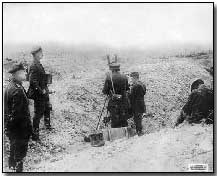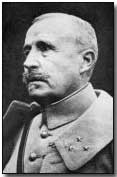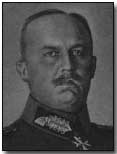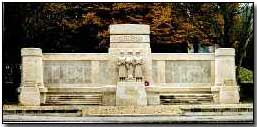Feature Articles - The Forgotten Boys of the Aisne Battlefields
 The Aisne (1914-15)
The Aisne (1914-15)
We first saw fire on the tragic
slopes
Where the flood-tide of France's early gain,
Big with wrecked promise and abandoned hopes,
Broke in a surf of blood along the Aisne
Alan Seeger, American Poet 1888-1916
During Remembrance Week each year attention inevitably turns to the battlefields of the western front, particularly the Ypres Salient and the Somme. These battlefields, these names, are powerful symbols of the First World War.
Here are the fields in which a nation's young men were sacrificed; etched on the nation's memory, a camera slowly panning across the countless white headstones of Tyne Cot Cemetery, Passchendaele. More and more 'pilgrims' visit the sites today than in any other period since the 1920's and 1930's.
It is possible to make a day's visit to the Somme or Ypres Salient and take in a number of cemeteries and memorials and visit a museum. These were, in a sense, self-contained battles where war waged back and forth over a number of years.
 The
neat lawns and herbaceous borders of the cemeteries belie the fact that 85
years ago this was a ruined countryside, a morass of battered trenches and
mud.
The
neat lawns and herbaceous borders of the cemeteries belie the fact that 85
years ago this was a ruined countryside, a morass of battered trenches and
mud.
Even today farmers still plough up bodies and other debris of the war. Much further south are the battlefields of the Aisne and the Marne, larger in extent, partly to do with the fact that the clash of continental armies had greater space in which to manoeuvre.
The battlefield here fits into a triangular area of land with the apex centred on Laon with Soissons and Rheims making up the points of contact on the other two sides. Remote, less visited by the British. In danger of being forgotten. To all intents and purposes this is specifically a French area of remembrance, and in recent years the French too have rediscovered a sense of their past.
This is evidenced by a new 'circuit of memory', set up by the Aisne Tourist Board which includes an open-air museum complete with visual display boards, and the 'Caverne du Dragon', a recently restored underground fortress, on the Chemin des Dames (the towering plateau above the Aisne river).
 But
the British were here too. And herein lies my personal interest.
It was only when I discovered my Great Uncle's Army Issue New Testament,
accidentally produced by a relative, that I became aware that Kitchener's
volunteers and the conscripts of 1917-1918 had fought in support of the
French on the Chemin des Dames in the last year of the war.
But
the British were here too. And herein lies my personal interest.
It was only when I discovered my Great Uncle's Army Issue New Testament,
accidentally produced by a relative, that I became aware that Kitchener's
volunteers and the conscripts of 1917-1918 had fought in support of the
French on the Chemin des Dames in the last year of the war.
This was, of course, in addition to the regular British Army who fought here in 1914. And the contrast with the Somme and most of Flanders is stark - here, on the Chemin, it is and was more lush, more pastoral, with rolling hills and vales and great swathes of woodland. An Officer who was there in 1918 wrote home:
"In trenches shadowed by green trees and the Bois de Beau Marais, gay with flowers and singing birds, the war bore a different aspect. Here surely was that hitherto phantom sector all had some day hoped to find."
This image does not fit in with the alien wasteland, the 'murdered strip of nature', that has become synonymous with the landscape of the Great War.
This Aisne region is no stranger to military action. Since the time of the Romans the Chemin des Dames ridge has been a commanding feature of the area, and numerous struggles for its possession have taken place down the centuries. The Aisne passage is one of the main gateways to Paris from the East.
 Napoleon, the supreme strategist, appreciated the obvious tactical
implication of holding the heights above the river, and won his last victory
here in 1814 en route to Waterloo.
Napoleon, the supreme strategist, appreciated the obvious tactical
implication of holding the heights above the river, and won his last victory
here in 1814 en route to Waterloo.
Victory was also scented here in 1917 by the French High Command. The 'wunderkind' of the French army, General Nivelle, promised the breakthrough to end the deadlock on the Western Front that the British had sought to achieve in 1916.
However, the attacking French troops who attempted to storm the rugged plateau of the Chemin des Dames from the Aisne river failed to deliver. This became the French version of the Somme, and Nivelle's own Waterloo.
Perhaps if Nivelle had absorbed the events that had taken place here in 1914 he would not have been so hasty. The British Expeditionary Force arrived on the banks of the Aisne in September 1914, footsore and drenched, but pleased that at last they were on the offensive.
After the battle of the Marne the confident German Army of the Kaiser was in the process of being pushed back. It decided to make a stand on the heights above the Aisne and dug in. It was here that the entrenching tools which British soldiers had carried in their packs from Mons to Le Cateau to the Marne were now made use of.
The First Battle of the Aisne, September 1914, witnessed the beginnings of modern trench warfare. The consequent frontal assaults on well-defended positions were quick to follow. The machine gun and the artillery battery were to come into their own.
 The
casualty list steadily mounted during the course of the conflict. The
BEF lost somewhere in the region of 13,000 men in just over a week, not
great by the standards of the attritional battles of 1916 and 1917, but
these losses amounted to a substantial rate of wastage for the
'contemptibly' small British Army of 1914.
The
casualty list steadily mounted during the course of the conflict. The
BEF lost somewhere in the region of 13,000 men in just over a week, not
great by the standards of the attritional battles of 1916 and 1917, but
these losses amounted to a substantial rate of wastage for the
'contemptibly' small British Army of 1914.
Many of these men lie forgotten in a small collection of Commonwealth War Graves Cemeteries mushroomed on the southern slopes of the Chemin des Dames, alongside their compatriots who died in 1918. At Vendresse British cemetery the geometrical, clean headstones vividly contrast with the surrounding woodland.
The site occupies a prominent spur on one side of the valley, and the meandering Aisne River can be seen in the distance. There are few spots on the western front that can compete for a more beautiful and tranquil setting.
My Great Uncle was one of the lucky ones to survive the 3rd Battle of the Aisne in 1918. The attack launched here by the German General Ludendorff was part of the last- ditch effort of the German Army to break the stalemate on the Western Front before the Americans arrived en masse.
Indeed, he nearly achieved his objective- the German army penetrated the Anglo-French lines for an unprecedented 11 miles on the first day of the offensive, before a lack of reserves and the regrouping of the Allies put paid to Ludendorff's plans. Nevertheless, thousands of British and French soldiers were taken prisoner.
The Aisne River had been breached by the Germans in this attack on 27th May 1918, and along the line of advance other memorials and cemeteries, both British, French and German are testimony to this fact. There is a memorial commemorating the Croix de Guerre won by the 2nd Devons at Ville-aux-Bois, for their brave but ultimately futile stand at the Bois des Buttes, standing incongruously next to the rather ordinary Mairie in the centre of this small village.
Across the river and over the ridges on the south bank the green hues of the Aisne Department merge abruptly into a more uniformly brown layered subsoil as this heavily worked landscape of the Champagne country is encountered.
At Hermonville British cemetery, near the main Laon-Rheims highway, are buried a number of men- many mere boys of 17-18, the 'draft of 1918'- of North Eastern Regiments, such as Percy Ryland of the 15th Durhams. He joined up in 1918 against his parents' wishes and was killed when only 17. His photograph has been left in the cemetery register, by his relative, sadly one of the few British visitors to the cemetery in recent years.
Yet another contrast emerges here. These boys, so many of them used only to a miner's life underground in the north, found their final resting place next to a picturesque, almost idyllic French village - just one more terrible irony.
 In the
last few years the market square in
Ypres has welcomed a large number of British visitors for Remembrance
Week. The 11th of November ceremony at the
Menin
Gate has a very impressive attendance, with the British Legion and
various regimental associations well represented. Similar ceremonies
take place on the Somme in November.
In the
last few years the market square in
Ypres has welcomed a large number of British visitors for Remembrance
Week. The 11th of November ceremony at the
Menin
Gate has a very impressive attendance, with the British Legion and
various regimental associations well represented. Similar ceremonies
take place on the Somme in November.
But the very understated (unusually modernistic) Memorial to the Missing of the Aisne battlefield, at Soissons, will be host to few tributes. Perhaps the sculptor Eric Kennington knew this; there is nothing triumphal here, like the more traditional memorials of Blomfield and Lutyens. Three squat soldiers standing (or lying, depending on perspective) shoulder to shoulder form the centrepiece of the memorial, which has 3,987 names engraved on the panels.
Many of the names are associated with the 50th 'Northumbrian' Division; the odd one or two stand out, like Bertram Cartland, the father of Barbara Cartland, but most are almost anonymous, seldom visited. The memorial in Soissons is difficult to find amongst the streets of this bustling town, but it is not far from the River Aisne over which Kennington's mournful figures - austere, reproachful- keep watch in death.
There are a number of tour operators that offer visits to the battlefields of the Western Front, but few that venture to British battlefields in the Aisne or Marne region. One that does is 'Flanders Tours', which can be contacted at:
Flanders Tours
PO BOX 240
ELLINGTON
HUNTINGDON
PE28 OYETelephone: 01480 890966
Fax: 01480 896087
e-mail: tntnoyes@aol.com
Article contributed by David Blanchard
An Armlet was a cloth band worn around the arm to identify a particular duty or function.
- Did you know?
